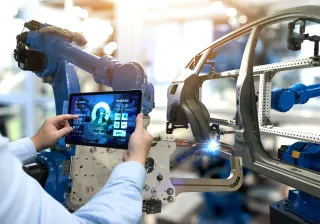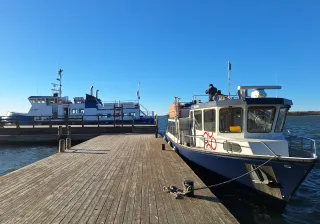Via digitalisation and cooperation with VTT, Hydroline, a traditional subcontractor for machine manufacturers, is branching out into services and software.
Mining machinery, waste compressors, cranes, drilling rigs, snowploughs, warehouse trucks, agricultural machines and truck tippers. Hydraulic cylinders are everywhere where outstanding power, reliability and high usability are in demand.
– Hydraulic cylinders convert a machine's energy into motion and power, summarises Manu Leinonen, VP Design and R&D, Hydroline.
New power from own product
Hydroline has been a fairly anonymous company, despite its 300 employees and revenue target of EUR 50 million for this year. This is largely because Hydroline has purely been a contract manufacturer. Now, this is about to change.
– Our Lifecycle Efficiency Online (LEO) application for predictive maintenance technology is our first product of our own. For a couple of years, our strategic goal has been to redirect our thinking and actions towards developing our own products.
This change of strategy has been strongly supported by our cooperation with VTT.
– We have been very open with VTT by boldly sharing our business plan, and VTT's experts have given us huge help in changing our strategy along the way, Leinonen says.
VTT and Hydroline have worked closely together. They collaborated on a joint application for an EU project beginning in 2014, packaging it so well that Hydroline was one of the few companies to receive funding.
– We have begun deep strategic cooperation with VTT's Oulu unit.
– Understanding Hydroline's business goals allows the planning of long-term collaboration over projects. Since the EU project, the development of the LEO application has continued naturally in a Business Finland-sponsored project, says Pekka Isto, Project Manager at VTT's Production and Machine Systems team.
Continuously monitored cylinders
The idea behind the LEO application is simple: it monitors the operation and condition of critical hydraulic cylinders for example in excavators, giving timely warnings if they are not functioning normally. The system pinpoints the critical component, enabling a maintenance engineer to check the situation and either repair or replace the cylinder.
Predictive maintenance saves machine operators a great deal of trouble and money.
An unexpected break in production in a single mining machine can cost EUR 50,000 per hour and, at worst, shut down an entire operation. In such a case, this means the loss of millions of euros per day.
Another key benefit of LEO is that the machine operator can see how the machine and its components have been used and the wear they have sustained. This is undoubtedly of major added value for the user.
Hydroline's application is not solely intended for its own cylinders. The system sensor module can be mounted on the cylinders of almost any manufacturer, either built-in during manufacturing or retrofitted during maintenance. For example, information can be obtained centrally, from a single system, on the condition of all machinery at a mine or construction site.
The application gathers information transmitted by sensors in the cylinders. The sensor data collected is transmitted to a cloud service via a 4G modem and via Bluetooth to a mobile application. The information provided by LEO is immediately available on a mobile application or Internet portal.
– We measure and collect pressure and positioning data from the cylinder sensors. We analyse and process this data into the most accessible and intuitive format, Leinonen explains.
Pressure data is collected on the cylinder's chamber pressure, and positioning data on its position. 1–3 data items are collected for each cylinder. This data can be used to analyse factors such as stress and the slide distances of cylinders. Additional sensors, which measure temperature or oil purity, can be connected to the system, if necessary.
The system currently analyses the operation of single cylinders. Data is also compiled into a single, large data mass. In the future, this will allow the comparison of cylinders with one another, deeper analyses of their performance, and the better anticipation of various types of malfunction.
First sales this year
Hydroline's creation of a new growth engine from digital services was well timed. Last June, the company received a financing package of EUR 20 million, with the investment company Juuri Partners as one of the main funders.
– We've got into this in good time – machine manufacturers have begun to explore the potential of IoT and are now setting requirements for the expertise of component manufacturers like us. We want to be able to meet those expectations.
LEO is important to the growth of Hydroline's service business. Digital services need to be part of your service range, if you want to be an innovative and openminded trailblazer in this sector.
– However, we have not forgotten our machine manufacturer customers. We can see that, as a tool, LEO is a major step into a new kind of product development within the network. The product can be used for the monitoring and measurement of prototype field tests, for example, comments Leinonen.
After years of development, LEO is ready for its first field tests.
– For the continuous improvement of our product, we are gathering experiences and development targets from field tests of small cranes and load handling machines, as well as machinery on mining sites.
LEO has already set clear targets for this year. The first sales should be made by the end of 2018.
Strong roots grow
Hydroline, which has been based in Siilinjärvi since 1962, is a pioneer in the design and manufacture of hydraulic cylinders. Its customers include global giants in machinery manufacturing, such as Agco Valtra, Bronto Skylift, Cargotec, John Deere, Rocla, Sandvik, and Normet. The company produces more than 1,800 cylinder models, making around 200,000 products a year in its production facilities at Vuorela in Finland and Stargard Szczecinski in Poland.
Its digital service operations are a direct continuation of Hydroline's open-minded, corporate culture of adopting and using the latest technology. In 1979, Hydroline became the first CNC machine tool manufacturer in its economic area. In autumn 2014, the company markedly boosted production by acquiring a friction welding machine for EUR 1.5 million.
Cost-effective, predictive maintenance
Olli Saarela of VTT states that predictive maintenance will become topical in the next few years, due to cost-efficiency requirements and challenging industrial conditions. Industrial companies are also seeking greater efficiency and automation in their production.
– The massive increase in data is the driver of growth in predictive maintenance. However, a major bottleneck exists in extracting and deploying useful information from the measured data for predictive maintenance, says Senior Scientist Olli Saarela (D.Sc. Engineering), a specialist in maintenance at VTT.
The risk of damage and reduced performance increases as devices become older. Saarela explains that the idea behind predictive maintenance is to opt for either inspection, repair or renewal in advance, based on the item and need in question.
– Predictive condition monitoring provides good basic data when deciding on maintenance. Detailed data on the use history, load, and environmental conditions is needed, in addition to information on symptoms. This enables successful maintenance, based on data analytics, as part of component lifecycle management. For example, it can provide information on the condition of bearings via sensors. If failures are rare, comprehensive measurement data cannot be acquired to be used as inputs in purely data-based computing models. In such a case, calculation reliability can be improved by incorporating knowledge of the physics and the chemistry of failure mechanisms and other relevant phenomena in the model.
Cost-effectiveness is based on good decisions
Effective and predictive maintenance utilises machine or plant operation and inspection data It reduces the fouling of components, prevents damage, and maintains operation.
On the other hand, in process plants component lifecycles are shortened by corrosive substances in synergy with the operating temperature, the internal cyclic thermal load, and mechanical load caused by pressurised water and steam.
Predictive maintenance aims to identify a plant's critical components and evaluate their condition through monitoring, condition inspections, and data analysis.
– Greater cost-effectiveness requires good decisions, which in turn require data from a range of sources such as condition inspections, material analysis, and process data, combined with understanding of failure mechanisms.




